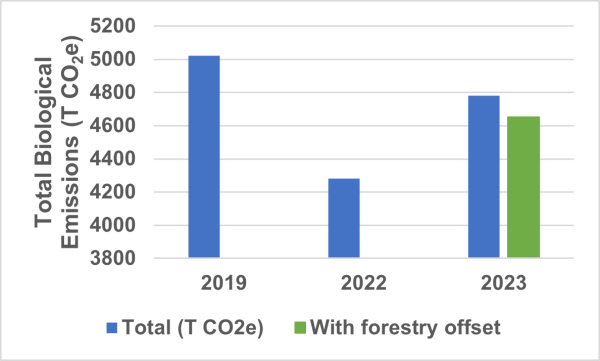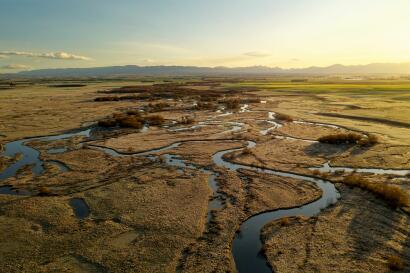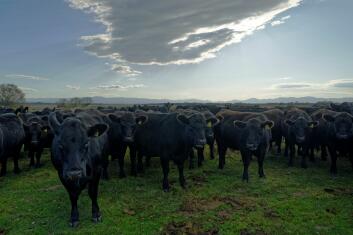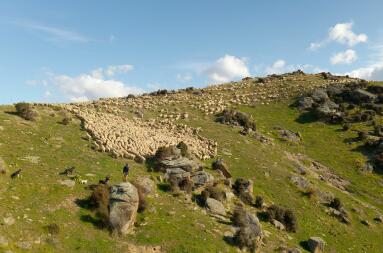Emma Crutchley and Kyle Hagen, Otago
Emma Crutchley's family have been farming on Puketoi Station in the Māniatoto since 1939. They've had to adapt to many issues outside of their control over this time. Keeping a positive mindset is helping them get their heads around the latest challenge - greenhouse gas emissions and climate change.
Video
Download this story
Download a copy of Emma and Kyle's story here [PDF, 673 KB] .
About the farm
Emma Crutchley and her husband Kyle Hagen farm Puketoi Station - a 2,885ha (2,737ha effective) sheep and beef farm in the Māniatoto, Central Otago. It has been in the Crutchley family since Emma's great-grandfather bought it in 1939.
Of the effective area, 1,300ha is hill/high country and 1,437ha flat, including 475ha of irrigated land. Emma and Kyle run approximately 6,500 romney crossbred ewes and an Angus beef stud. The irrigated land is used for lamb finishing and arable cropping. The table below shows Puketoi Station's physical parameters.
| 2019 | 2022 | 2023 | |
| Effective ha | 2,797 | 2,737 | 2,737 |
| Breeding ewes | 7,100 | 6,590 | 6,601 |
| Breeding cows | 160 | 163 | 145 |
| Total Stock Units | 15,919 | 13,860 | 14,877 |
| SU/ha | 5.4 | 5.1 | 5.5 |
| Arable crop (ha) | 32 | 40 | 59 |
The farm has very low rainfall - just 350mm per annum - and has experienced some very severe droughts over the years and long winters. These challenging conditions require a flexible approach to farming.
"We're at the mercy of Mother Nature," says Emma. "Our farming system is very closely intertwined with the environment and we're always looking for ways to lighten our impact."
GHG numbers
Since 2009, Emma and Kyle have become increasingly aware of the attention on agriculture's contribution to climate change. Emma attended a greenhouse gas course through Massey University in 2019, which helped her understand the main sources of emissions at Puketoi.
The farm team has always had a focus on per animal production, rather than driving for more animals to derive output. With Emma's new knowledge in hand, they set out to alter the system to reduce emissions while retaining profitability and meeting broader family goals for the environment.
The table below shows Puketoi's greenhouse gas numbers since 2019:
| 2019 | 2022 | 2023 | % change 2023 v 2019 | |
| Methane (total T CO2e) | 4,114 | 3,652 | 3,944 | -4% |
| Methane (T CH4)* | 165 | 146 | 158 | -4% |
| Nitrous oxide (total T CO2e) | 909 | 630 | 814 | -10% |
| Total tonnes CO2e** | 5,487 | 5,131 | 5,444 | -1% |
| Total tonnes CO2e**/ha | 1.90 | 1.78 | 1.89 | -1% |
*The weight of methane is shown here without conversion to carbon dioxide equivalence (CO2-e) because this is how it will be reported in the farm-level pricing mechanism.
**Includes CO2 emissions from fertiliser, noting that these will not be included in the farm-level pricing mechanism.

Puketoi total biological emissions (methane and nitrous oxide) since 2019
As shown in the table and the graph above, there has been a decrease in total emissions and nitrous oxide emissions since 2019 and a very small reduction in methane (albeit an increase between 2022 and 2023 due to an increase in stock numbers - less capital stock was offset by more trade lambs).
Emma and Kyle use OverseerFM for their farm’s greenhouse gas numbers. To find out more about this tool and others, see our Know Your Numbers page.
On-farm actions
Emma and Kyle made three main changes on Puketoi that has helped reduce their emissions:
- Decreased winter crop area by 28.8% from 184ha to 131ha and a reduction in N applied to crops from 59kgN/ha to 27kgN/ha – decreased nitrous oxide emissions.
- Decreased total stock units by 1.5% from 15,191 to 14,962 and increased total liveweight sold (kg/ha grazed) – decreased methane emissions.
- Decreased total beef RSU by 17% - decreased methane emissions.

Upper Taieri Scroll Plain and wetland complex (Photo: Dave Allen Photography)
In addition, some land was taken out of production in order to plant up riparian strips and regenerate a wetland. In many respects, the efficiency of the farm system has improved, resulting in a reduction in greenhouse gas emissions, while maintaining the financial sustainability of the business.
Emma and Kyle’s initial focus was on building more resilience into their farm system, reducing stocking areas knowing they could get better performance with less stock. This was based on multi-generational knowledge and incorporating that into the farm system.
The shift to arable over the years also aligned with the resources they had and market demand. Careful consideration was given to appropriate crops as many are not suited to the extreme climate at Puketoi. Cropping was also introduced gradually to ensure there was a market for what they were producing. They have converted most of their border dyke irrigation to centre pivot. This was primarily done for water use efficiency and water quality management, but also supported wider changes to the farm system.
To read more about what actions to reduce agricultural greenhouse gas emissions, see our Current Actions page.
Impact of the changes
The changes that Emma and Kyle have been making are not just helping the climate. They report that it is easier now to maintain ewes in good condition all year round. In addition, creating flexibility reduces pressure on the family business (financial performance has stayed relatively similar in real terms).
They have been striving for improved lambing percentage, but various disruptions (beyond their control) since 2019 have hampered this. They are confident this improvement will still come.
The overall environmental footprint has always been a focus, but lowering greenhouse gas emissions has also reduced nutrient losses. It has also provided greater resilience to market changes as a result of increased flexibility in the system. It has enabled them to focus on resilience for the business in relation to water, biodiversity, adaptation to climate change, climate change policy and labour as well as animal welfare. The changes have also enabled retirement of lesser productive areas, much of which they are planting with trees (exotic and native).
Future changes
Emma and Kyle are keen to move to more arable. To do this, they would need to know there were markets at the end of it and would also need to have processes in place to manage climate risk to be able to make that shift confidently.
Stock numbers are “about right now”; the continued effort in the system will be in driving per animal performance. They would look to reduce stock numbers further if that supported reduced emissions and retained profitability. Low methane genetics will also be explored for the maternal flock.
The timing of sale of trade lambs has an influence on emissions (lambs held longer increase emissions). The trade lamb policy could be adapted to reduce emissions further.
Emma and Kyle are also interested in being part of the solution to support greater resilience and sustainability in the local food network. They are members of their local catchment group working to be part of collective solutions to tackling challenges like climate change and local food networks.
Actions for climate resilience
Farming is not only having to transition to a future where fewer greenhouse gases are emitted, but also one where resilience to the impacts of a changing climate is strengthened.

Angus beef cows at Puketoi Station. (Photo: Dave Allen Photography)
This is front of mind for Emma and Kyle, given the extreme environment at Puketoi. The following actions are helping them build resilience into their system:
- Use a terminal sire over 40% of their ewes to provide flexibility with lamb sales.
- Beef cows are used across all land types (including irrigated) as a tool for managing feed quality.
- Integration of wide shelter belts (which are in the ETS).
- Riparian areas are retired and planted with natives.
- Produce a lot of their own seed on-farm (clover, ryegrass and lucerne).
- Direct-drill except when incorporating straw.
- 95% of irrigated area of the farm is spray-irrigated (more efficient water use than previous border-dyke).
- Use lucerne to help finish lambs faster and provide greater flexibility with lambs.
Advice for other farmers
Below are some suggestions from Emma and Kyle to help other farmers get their heads around the opportunities and challenges in reducing agricultural greenhouse gas emissions and adapting to a changing climate:

Mustering at Puketoi Station (Photo: Dave Allen Photography)
- It is important to know what problem you are trying to fix and know what the options are to do it. Often the solution to the problem is counter-intuitive to what you think. For example, reducing stocking rate may seem counter-productive, but with increased per animal performance you can be better off. Similarly farming to the carrying capacity of the land rather than chasing a particular policy.
- Be aware that as per head production increases, emissions may also increase so there is a need for constant adjustment.
- Modelling options can help de-risk making changes and give you confidence to make them.
- Important to reflect on what you’ve got and be grateful for that. That helps with a mindset of supporting and nurturing what you have.
- Consider everything through a lens of opportunity, rather than a challenge or a threat.
- Think across the multiple challenges that are being faced regardless of policy incentives its important to focus on solutions that can tick off multiple challenges. For example, shelter is also sequestration, or riparian quality can support water quality and biodiversity outcomes.
"As farmers, we have no control over the cards we're dealt," acknowledges Emma. "But, we can decide how we play them and that's the exciting bit."
Know your numbers and have a plan
By now, all farmers and growers must have a record of their annual on-farm greenhouse gas emissions (methane and nitrous oxide). By the end of 2024, they'll also need to have a written plan in place to manage them. These requirements are part of the He Waka Eke Noa partnership and are intended to help get farmers ready for agricultural greenhouse gas emissions to be priced from 2025. To find out more on how to do this, see our Know Your Numbers page.

